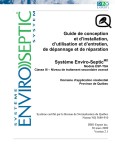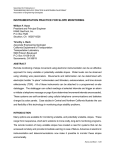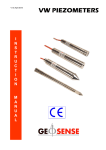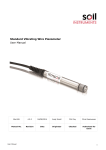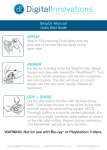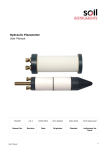Download User Guide Enviro
Transcript
User Guide Enviro-Septic System Residential Application DBO Expert inc. February 1st, 2005 Enviro-Septic System – User Guide Table of Contents Table of Contents 1 Introduction 2 The purpose of the document 2 Designation of the System 2 Enviro-Septic System Capacity 3 Enviro-Septic System Operating Instructions 4 Context 4 Wastewater Volume 4 In the bathroom 4 In the kitchen 5 For the laundry 5 Elsewhere in and around the house 5 Aeration 6 Heavy machinery and motorized vehicle traffic 6 Vegetation 6 Enviro-Septic System Components 6 Enviro-Septic System Maintenance 8 Septic Tank Maintenance 8 Pre-filter 8 (Septic tank effluent filter) 8 Enviro-SepticMD 9 Pipe Rows 9 Piezometers 9 Sampling device 9 Vent 10 Filtering Sand 10 Owner’s Responsibilities 11 Owner’s Responsibilities 11 Qualified person 11 What to do if water level is high 12 Enviro-Septic System Follow-up Agreement 14 Context 14 Included in the Enviro-Septic System follow-up agreement 14 Additional Information 16 Information on your Enviro-Septic System 16 Notes 16 February 1st, 2005 1 Enviro-Septic System – User Guide Introduction Congratulations! You have chosen the Enviro-Septic System for your septic installation. Your System was conceived to effectively treat wastewater from the septic tank of your isolated residence 12. However, certain instructions must be respected in order to maintain its treatment performance so that you can make use of it for many years. We invite you to take note of this document and keep it in your files for future reference. The purpose This user guide explains the rules of use and the follow-up requirements to respect in order to ensure the correct operation of an Enviro-Septic System of the for residential wastewater treatment. document It mentions the owner’s responsibilities with respect to the municipal requirements and regulations applicable to the Enviro-Septic System. Designation of the System Name : Système Enviro-Septic Application : Residential. Definition : The Enviro-Septic System is composed of two indissociable main components: Enviro-SepticTM pipes and a layer of filtering sand. A septic tank and a distribution device for wastewater must precede the Enviro-Septic System. The system is placed above natural soil where water is evacuated. 1 The term isolated residence is defined as a single-family residence with 1 to 6 bedrooms or any other building generating a daily total flow of wastewater of domestic nature equal to 3240 liters or less February 1st, 2005 2 Enviro-Septic System – User Guide • Enviro-Septic System Capacity Single family residence: Number of bedrooms Total daily flow (L/d) 1 2 3 4 5 6 540 1 080 1 260 1 440 1 800 2 160 Minimum number of 3,05 m lengths of Enviro-Septic® pipe 8 12 15 18 22 26 Total minimum length of Enviro-Septic® pipe (m) 24,4 36,6 45,8 54,9 67,1 79,3 Example: For a one-family residence of 3 bedrooms, the Enviro-Septic System must contain a total minimum length of 45,8 meters of EnviroSepticTM pipe and its capacity (total daily flow) is 1260 liters of domestic wastewater per day. • Other buildings: Minimum number of 3,05 Total daily flow m lengths of Enviro(L/d) Septic® pipe 540 8 810 10 1080 12 1260 15 1440 18 1620 20 1800 22 1960 24 2160 26 2280 28 2440 30 2600 32 2760 34 2920 36 3080 38 3240 40 February 1st, 2005 3 Total minimum length of Enviro-Septic® pipe (m) 24,4 30,5 36,6 45,8 54,9 61,0 67,1 73,2 79,3 85,4 91,5 97,6 103,7 109,8 115,9 122,0 Enviro-Septic System – User Guide Enviro-Septic System Operating Instructions Context The use and the maintenance of an Enviro-Septic System are relatively simple. In general, the use of a reasonable quantity of water in the residence and compliance with the rules that follow will make it possible for you to use your installation without problems, and for many years. In the paragraphs that follow, you will find the basic rules to comply with in order to ensure the correct operation of your Enviro-Septic System. The compliance of the majority of these rules is essential to the correct operation of any septic installation. In order to facilitate comprehension, these rules are presented to you as things to do or not to do in each part of the house, as well as outside. Wastewater Volume Large quantities of water that leave the house and enter the Enviro-Septic System in a short lapse of time have a negative impact on the effectiveness of the treatment and the infiltration of wastewater. Large quantities of water can cause agitation within the septic tank. A certain quantity of sludge or scum is susceptible to be put back into suspension and be brought towards the System and the infiltration bed. The frequency of such an event must be minimized. You must ensure that the volume of wastewater entering the Enviro-Septic System is reasonable when compared to the total daily flow. If the residence’ s vocation changes when compared to what it was at the time of the Enviro-Septic System installation, you must ensure that you communicate with a qualified person in order to check that your septic installation has the necessary capacity to treat and infiltrate the polluting loads and volumes of wastewater which will be generated. In the bathroom You must : • immediately repair any leaking faucet or toilet; • use a reasonable quantity of toilet paper. Do not : • use disinfectant in tablet (puck) form, whether it is placed in the basin or the tank; • throw cigarettes, cigarette butts or medication in the toilet; • throw tissue paper, paper napkins or other personal hygiene products in the toilet. February 1st, 2005 4 Enviro-Septic System – User Guide In the kitchen You must : • repair any leaking faucet • use dish soap (or dishwasher soap) low in phosphate (0 with 5%) • use the necessary quantity of soap to do the work. Take note that the necessary quantity is often less than suggested by the manufacturer. • dispose of vegetables, meats, fat, oil, coffee beans or other products not digested beforehand elsewhere than in the septic installation. Do not : • use a food waste disposal unit in your sink that is connected to your septic installation For the laundry You must : • use phosphate free detergent, preferably in liquid form. If it is not possible, use biodegradable powder detergent. • use the necessary quantity of soap to do the work. Take note that the necessary quantity is often less than that suggested by the manufacturer • minimize the volume of water used for the laundry according to the quantity of clothing to wash. Elsewhere in and around the house You must : • divert drainage water away from the site where the Enviro-SepticTM pipes are installed. Do not : • discharge water softener backwash into your septic installation • discharge any water from swimming pool filters, spas or other appliance that discharge chlorinated water into your septic installation • let water from sump pumps, roof drains (gutters) and drainage pipes discharge into the septic installation • dispose of solvents, paints, antifreeze, engine oil or other chemicals in the septic installation. This includes water used to wash brushes or rollers that were used with latex paint (latex paint contains elements that are harmful to septic installations) • dispose of animal litter in the septic installation. February 1st, 2005 5 Enviro-Septic System – User Guide Chemicals for septic installation Your Enviro-Septic System does not require any starting chemical, cleaning or other additives. The bacteria that carry out the treatment are naturally present in wastewater of an isolated residence. Any chemicals or additives added to the Enviro-Septic System could possibly kill these bacteria Aeration It is very important to ensure good aeration occurs so that the septic installation functions correctly. The vent (or vents) installed at the exit of the septic installation encourages this aeration. It is important to make sure that the opening is not blocked and that air can circulate freely at all times. Heavy machinery and motorized vehicle traffic No heavy machinery must be driven on a septic installation, whether it is before, during or after its construction. It is the same for any motorized vehicle. The effectiveness of the drainage in the ground depends on the presence of a non-compacted natural soil that is unsaturated with water. Heavy machinery or motorized vehicle traffic on the soil closes the natural pores of the soil which favors the accumulation of water. Vegetation The surface of the septic installation must be planted with grass. The grass must be cut regularly in order to encourage growth without the use of fertilizers. Vegetation cover contributes to the elimination of nitrogen and of the phosphorous. Il is important not to plant trees or other plants with invasive roots within the proximity the septic installation (minimum distance 2 meters). Enviro-Septic System Components Your septic installation includes several elements other than the EnviroSeptic System. All of these components form a part of the treatment process of your installation. The following table presents the list of these elements. However it should be noted that some of these are only used when site constraints require them and when the contractor chooses to use them. The table also presents a summary of the follow up requirements for each component. More detailed information on this subject is presented in the sections that follow. February 1st, 2005 6 Enviro-Septic System – User Guide Enviro-Septic System Components Component of the Function septic installation Follow-up done by owner Follow-up done by qualified person Septic tank Primary wastewater treatment Yes Pre-filter(septic tank effluent filter) (optional, unless a low pressure distribution(or feed) system is used which makes it mandatory) Distributions system Retention of solids that are larger than the maximum openings of the filter. According to the manufacturer’s directions No, unless municipal regulation According to the manufacturer’s directions. Distributes the septic tank effluent to the rows of Enviro-SepticMD A) No A) Yes, depending on the water levels in the piezometers. A) Adjust when needed B) Pressure distribution (feed) system B) According to the manufacturer’s directions. B) According to the manufacturer’s directions. B) According to the manufacturer’s directions. C) C) According to the manufacturer’s directions. No C) According to the manufacturer’s directions. Yes, according to the water levels readings in the piezometers Yes, During follow-up visits C) According to the manufacturer’s directions. Occasional / regular maintenance done by a qualified person Yes, empty according to enforced standards Yes, according to the manufacturer’s directions. 3 options A) Distribution box and flow equalizers Wastewater distributing valve Rows of Enviro-SepticMD Pipe. Distribute and treat wastewater Piezometers To check the water level of each row of EnviroSeptic pipe Sampling device To verify the treatment performance of the Enviro-Septic System To allow the circulation of air in the EnviroSeptic System To complete the water treatment process and to improve the drainage lift septic tank effluent to the Enviro-Septic System Vent Filtering sand Pumping station (optional) February 1st, 2005 Yes for preventative measures before pumping out the septic tank Optional Yes, Ensure that the opening is not blocked No No Optional No Yes No No No According to supplier’s specifications 7 When needed Enviro-Septic System – User Guide Enviro-Septic System Maintenance Septic Tank Maintenance The septic tank must be pumped out regularly. The Ministry of the Environment requires that the septic tank of an isolate residence be pumped out at least every two years and in the case of a seasonal installation, at least every four years or according to the applicable regulations in your municipality. For more details, to see article 13 of the regulation Q-2, r.8 and communicate with your municipal officer. The liquids and solids will be removed when pumping out the septic tank. The septic tank is then filled with water. At all times, a professional using the proper equipment must carry out the pumping out of a septic tank. The owner is responsible to ensure his septic tank is pumped out according to regulation in effect. Attention: The owner should make sure that at all times, the septic tank covers are in their proper position. A cover that is not installed correctly can be harmful to the operation of the Enviro-Septic System. Moreover, entering a septic tank can be very dangerous. A qualified person must always do this work. Pre-filter (Septic tank effluent filter) The pre-filter is an optional piece of equipment that can be used in the septic tank. However, it must be used with every low-pressure distribution system. The pre-filter must be cleaned according to the maintenance and inspection procedures provided by the manufacturer. Distribution box and flow equalizer Normal use of your septic installation should not require the adjustment of the distribution box and the flow equalizer. The initial adjustment and the self-leveling capacity (natural adjustment) of the flow equalizers are normally enough to maintain a good distribution of water among the rows of EnviroSepticTM pipe. However, a difference of more than 100 mm between the lowest and highest water level in the piezometers for two consecutive measurements indicates that the equalizers should be adjusted. A qualified person must then carry out the adjustment(s). February 1st, 2005 8 Enviro-Septic System – User Guide EnviroSepticMD Pipe Rows Under normal use, the rows of Enviro-SepticTM pipe do not require maintenance. It is normal to find the water level fluctuate a certain amount in the pipes. On the other hand, if the water level(s) reaches 260 mm, a rejuvenation of the Enviro-Septic System must be considered. A qualified person must carry out this procedure. Piezometers No maintenance is required on the piezometers. However, the owner must ensure that the caps are in place. Sampling device The Enviro-Septic System must have a sampling device. A pipe of 100 mm in diameter closed off by a cap must be above ground-level, located on the outside of the rows of Enviro-septic pipe that are supplied with effluent from the septic tank (see figures 1 and 2). The owner must make sure that the cap is always on the sampling device. This device will be used on occasion by a technician to inspect the performance of the Enviro-Septic System according to requirements set by the Ministry of the Environment. Enviro-Septic System Components installed in ground Vent Septic Tank Distribution box Sampling device Enviro-Septic Pipes Fig. 1 February 1st, 2005 9 Piezometer Enviro-Septic System – User Guide Enviro-Septic System Components shown above ground level Vent Septic tank cover Piezometers cover Sampling device Fig. 2 Note: The position of the components can vary according to the layout configuration. The dotted lines represent the position of the septic tank and the Enviro-Septic System. Vent The vent does not require any maintenance. The owner must however ensure that nothing prevents the circulation of air. In the winter, the opening of the pipe must be sufficiently high so that snow does not block the passage of the air. At any time, there must also be a difference of at least 3 meters between the high and low vent. Filtering Sand There is no maintenance to be done out on the filtering sand during normal use of the Enviro-Septic System Pumping station or low pressure distribution system In certain cases, the site constraints require the use of a pumping station or a low-pressure distribution system to evenly distribute the water. The owner is then responsible to comply with the manufacturer’s schedule maintenance requirements of this equipment. Surface embankment above the Enviro-Septic System The surface of the embankment located above the Enviro-Septic System must be covered with herbaceous vegetation. A light slope must be given to surface in order to help the drainage of rainwater towards the outside of the System. The grass must also be cut regularly. Finally, any depression that could be created with time must be filled in order to avoid any accumulation of water above the System. February 1st, 2005 10 Enviro-Septic System – User Guide Owner’s Responsibilities The owner is responsible to : Owner’s Responsibilities • • • • • • • • Qualified person use the Enviro-Septic System according to the instructions' presented in the user guide. pump out the septic tank according to the regulations in effect. record the information for the pumping out of the septic tank and forward the information to DBO Expert Inc. maintain the pre-filter, the pumping station, the pressure distribution system or the wastewater distributing valve according to manufacturer’s specifications and record the information. have at all times an agreement in place with DBO Expert Inc, its representative or a qualified person in order to carry out the followup of its Enviro-Septic System give a copy of the agreement to your municipality. ensure the vent openings are clear of any obstacle. respect the requirements of the applicable rules and regulations, in particular with regards to the discharge standards of the system and the environment (other public organization or Ministry of the Environment). The qualified person(s) that perform the maintenance or the follow-up of an Enviro-Septic System is a person who was trained by DBO Expert Inc to perform the tasks associated with the System Enviro-Septic. DBO Expert Inc trains these people to carry out the adjustments of the equalizers as well as carrying out the rejuvenating procedure. To obtain the name of a qualified person in your area contact our customer service department. For maintenance on the pumping station and the pressure distribution systems, the owner must refer the user guide specified by the manufacturer of these systems. The pumping out of the septic tank must be performed by a company specializing in that field . Check with your municipality for the companies in your area that are qualified to do this work. February 1st, 2005 11 Enviro-Septic System – User Guide What to do if water level is high With time, the water level can increase in the Enviro-SepticTM pipes. It is normal to find a certain water level in the rows of Enviro-SepticTM pipes. A high level represents an unusual case. Fortunately, the Enviro-Septic System has the capacity to rejuvenate itself, i.e., that it is possible to practically recreate the original conditions of the water treatment of the Enviro-Septic system even if this situation should appear. If the level of water in the piezometers exceeds 260 mm (10,5 inches),The DBO Expert Inc technician (or representative) will inform you of what needs to be done. As a general rule, we will suggest one of the following rejuvenating procedures. There are three rejuvenating procedures possible. 1. The natural rejuvenation that occurs following a reduction of use of the septic installation for a period of a few days or weeks (e.g. during a vacation). 2. The forced rejuvenation that consists of pumping out the septic tank and removing water from the Enviro-SepticTM pipes at the same time. 3. The forced rejuvenation with cleaning that consists of draining the septic tank and removing water and the inorganic matter that could have accumulated in the pipes over the years. A qualified person must carry out the forced rejuvenation procedures. Occasionally, at the time of a forced rejuvenation, the septic tank is not filled with clear water as in the case of a normal draining. This procedure must then be made at the time when the groundwater is low and that there is no danger that hydrostatic pressure is exerted on the septic tank. As a preventive measure, it is recommended to check the water level in the piezometers a few days before performing a regular pumping out of the septic tank. If the water level is too high, the pumping out of the septic tank could be done at the same time a forced regeneration procedure occurs. February 1st, 2005 12 Enviro-Septic System – User Guide Procedure for measuring the water level in the piezometers The procedure for measuring the water level takes place where the piezometers are located at the extremity of the Enviro-Septic System. The DBO Expert Inc’s technician will make sure that the owner understands the method to be used, either at the time of the first follow-up visit for the System, or at another time. Attention: Water present in the piezometers is wastewater. It is important to take the necessary precautions while taking the water level measurements. The person taking the measurement must wear protective gloves. The use of disposable protective gloves is recommended. In order to avoid a possible contamination, avoid the direct contact with wastewater. Water level measuring sequence 1. Remove the cap from the piezometer. 2. Insert a wooden stick or a yardstick (measuring instrument) into the piezometer so that it comes in contact with the water that can be present in the piezometer and the bottom of the piezometer. Normally, a wooden stick of one meter in length will be sufficient. If on the other hand your piezometers are longer, use a longer wood stick. A string attached to the wooden stick can also be used in this case to lower and lift your measuring instrument in the piezometer. 3. By using a ruler (or directly on the yardstick), determine the water level in the pipe by observing the height of the wet area. If the reading proves to be difficult, add some fine sand on the wet area before lowering it in the piezometer. Most of the sand will be removed from the area that will have soaked in water and the reading will be easier. 4. Note the water level of the piezometer. 5. Replace the cap on the piezometer 6. Dry the wet area on the wooden stick (or directly on the yardstick) using disposable rags. 7. Repeat all the steps for each piezometer. 8. Clean the yardstick, the wooden stick or the gloves if they are reusable. Put disposable gloves and rags in a closed plastic bag in an adequate way. 9. Record the results obtained in the table provided with your follow-up contract and send the data acquisition card to DBO Expert. Vent Aeration pipe Water level measuring stick Diagram of water level measurement piezometer Fig. 3 February 1st, 2005 13 Enviro-Septic System – User Guide Enviro-Septic System Follow-up Agreement Context According to article 3.3 of the Q-2,r.8. Regulation respecting wastewater disposal systems for isolated dwellings the Ministry of the Environment requires that any owner of a treatment system that falls under articles 11.1, 16.1, 87.7, or 87.13 have at all time a current follow-up/maintenance agreement with the supplier of the System, his representative or a qualified person. A copy of this agreement must also be given by the owner to his municipality. Included in the EnviroSeptic System follow-up agreement The following elements must be included in the follow-up contract of a Enviro-Septic System: Annual follow up visit • (beginning the following calendar year after the installation) • Follow-up visit each year must be performed to verify the good operating condition of the system. The visit consists of the following task: • Check the water levels in the piezometers. • Adjust the equalizers if required. • Visually inspect the ground conditions (resurgence, surface water run-off, condition of the vent, piezometers, sampling device, etc.). • Make recommendations to the owner if required. • Carry out random sampling in order to respect the Ministry of the Environment requirements. • If the customer is present, train him on the measuring procedure. Note: the cost of pumping out the septic tank is not included in the follow-up contract. It is the same for the costs for draining or cleaning for the pipes during the time of a regeneration procedure. February 1st, 2005 14 Enviro-Septic System – User Guide In the case that the Enviro-Septic follow-up is done by a third party If a qualified person who is not from DBO Expert Inc carries out the followup of the Enviro-Septic System, a proof of the agreement between this third party and the owner must be sent to DBO Expert Inc. Customer service and technical support Do not hesitate to contact our customer service if you require additional information. In this case, a system follow-up report will have to be provided to DBO Expert Inc by the qualified person after each visit that he will have carried out for the follow-up of the system. The owner will have ensure that a copy of the follow up report is sent to DBO Expert Inc. in order to maintain the warranty on the Enviro-SepticTM pipes. Here are the coordinates to contact us : Telephone : 1.866.440.4975 ou (819) 562-4975 Fax : (819) 846-2135 Email : [email protected] Web site : www.enviro-septic.com February 1st, 2005 15 Enviro-Septic System – User Guide Additional Information Information on your Enviro-Septic System Installation date: _____________________________ Contractor /Engineer: ___________________________________________ Installer: ____________________________________________________ Municipal inspector: ____________________________________________ Number of rows of pipes: ___________________ Number of 3.05 meter pipes per row_________________ Water • • • • Distribution Distribution box Pumping station Wastewater distributing valve Pressure distribution system Septic tank capacity: ______________________________ Notes February 1st, 2005 16

















